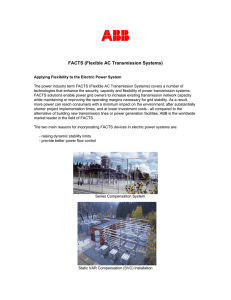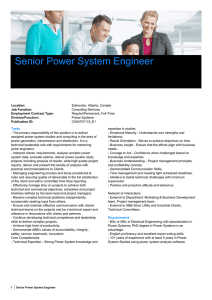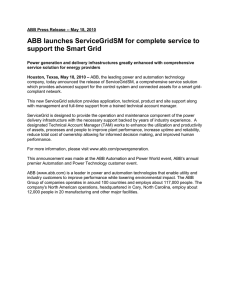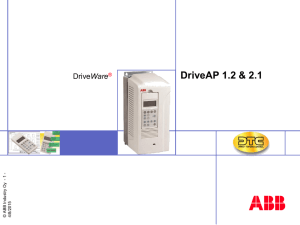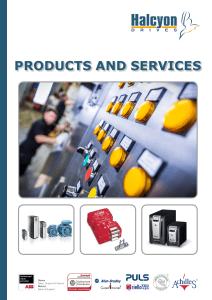ABB View on Carbon Abatement and Energy Efficiency
advertisement
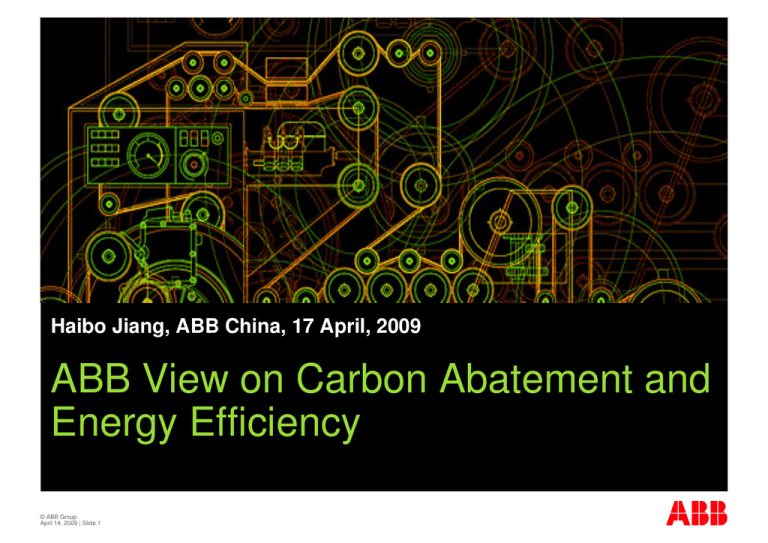
s Name, department/event, date Haibo Jiang, ABB China, 17 April, 2009 ABB View on Carbon Abatement and Energy Efficiency © ABB Group April 14, 2009 | Slide 1 Executive Summary There is a quicker, cheaper and more effective way of reducing carbon dioxide emissions that can be applied right now: energy-efficient technologies that are commercially available and proven. Energy efficiency is the lowhanging fruit in the campaign to protect the environment because the technologies exist and we know the savings they will deliver. It could be useful to employ the concept of the accumulation effect. Which means that a consumption avoidance lower down in the energy value chain has the higher impact, due to the implied savings up in the chain. Thus focusing on efficiency (production and energy!) in the industrial manufacturing processes at the end of the energy chain is far more critical than attempting costly fine tuning on the generation side. In industry, the biggest reductions in emissions in the short term will come from measures to run processes more efficiently. Again technologies are existing and have a fast payback, and a very high net energy gain. © ABB Group April 14, 2009 | Slide 2 Available energy Reducing losses along the energy chain Primary energy Transport Improved well efficiency Higher pipeline flows Mine Hoist T&D Generation Modular Propulsion Lower line losses, Turbo-charger More efficient higher substation fuel combustion AC Drives efficiency Efficient Motor Crane CPSS Optimax System Green RTG HV AC Drives HVDC & FACTS Efficient Transformer Is Limiter Process Automation © ABB Group April 14, 2009 | Slide 3 Marine & pipelines Power plant automation Grid operation Industrial production Industrial processes ABB technology can reduce losses by 20-30% i.e. doubling the yield! More efficient motors & drives AC Drives Efficient Motor Drives & motors Improved productivity & quality Control System Asset MGMT Process automation The accumulation effect of the industrial value chain efficiency (see explanations on the next page) The further down the value chain energy consumption get’s avoided, the more elements up the chain are also avoided as a consequence. This weighs especially heavy, if the efficiency in the beginning of the chain is low (e.g. the only max 40% of primary and secondary power generation). Assuming that investments to achieve one incremental efficiency gain unit are equal, the focus should thus be on opportunities close to the final consumer. In the example they would be 12.5/4>3 more capital efficient. In reality, the investments in the early part of the chain are more expensive and have a far slower payback, even further amplifying the effect. Even stronger is the impact of an avoided scrap element. Now the total accumulated effect jumps in the example up to 35 avoided energy input units. © ABB Group April 14, 2009 | Slide 4 Explanations An obvious effect is that a unit of something saved has a higher impact than producing a unit with slightly higher efficiency. When looking at a value chain, saving a unit far down the chain saves the cumulated inefficiencies of the chain elements before. On the previous slide, the following terms are used: Extraction, Generation, Transmission: for simplification, the energy value chain steps of mining or upstream, generation of secondary power, and electricity transmission to the load center are summarized in this element. The typical total efficiency is less than 40% (e.g. 80% for the upstream and fuel transport, 45% for the generation, and 95% for the transmission process). Manufacturing Process Energy: this element summarizes the energy efficiency of the manufacturing process as such. Given the dominance of motor applications, process steam and heat, an efficiency of 50% was picked. This leads to an overall efficiency of 20% up to this point. Which represents the end-point of the classical view of the energy chain. Manufacturing Process Control: here the ability of a process to produce the intended yield is meant. The efficiency of 70% represents the product units that are actually made to specification and at the right time for consumption. The missing 30% are scrap and waste as well as rework. This leads to a total value chain efficiency as landed efficiency of 14% in terms of energy input that actually sits in useful products. Now comes the accumulation. Since the generation is only 40% efficient, an energy unit saved in the production on the consumption end saves 1 / 40% or 2.5 times as much. In the example, instead of the 5 units also the units in the chain before, that means 12.5 units. The same logic applies, if actually a product scrap unit is avoided in the third step. Now we have 1 / 40% * 1 / 50% = 5. So instead of the © ABB Group incremental 7 energy units actually 35 are saved throughout the energy value chain. April 14, 2009 | Slide 5 Levers for efficiency – from conventional to advanced Plant Energy Management Advanced Process Technology Plant TQM and scrap avoidance Input Process Advanced Process Control Input © ABB Group April 14, 2009 | Slide 6 Right-sizing plant and processes Production efficiency levers Output High efficiency equipment Total Plant Optimization Output Energy efficiency levers ABB High Efficiency Products and Technologies High efficiency rotating (Motors&Drives) High efficiency power transmission (HVDC, FACTS) High efficiency transformers Advanced process control (PMS, Expert Optimizer) Driving Propulsion System (Azipod®) High Engine Efficiency Turbocharging Green RTG High efficiency Robotics Technology Intelligent Building Control System (i-bus) Energy Management Contract © ABB Group April 14, 2009 | Slide 7 © ABB Group April 14, 2009 | Slide 8

